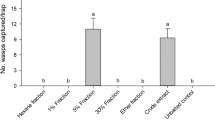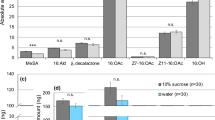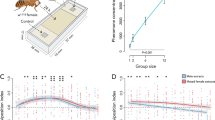Abstract
AMONG insects known to use a sex pheromone, it is most common for one sex to respond to the chemical signal produced by the opposite sex1. Yet in some species, apparently both sexes respond to the pheromone2,3, and recently it has been shown, in a few cases at least, that the two sexes may produce distinct pheromones4,5. Tenebrio molitor has previously been regarded as a classic case: females excite and attract males by means of a sex pheromone6,7. There are several pheromones which mediate the reproductive behaviour and physiology of Tenebrio, and we have found that the males as well as the females produce sex pheromones. Furthermore, the male pheromones are of two distinct types: (1) an excitant which attracts females and (2) an ariti-aphrodisiac which inhibits the response of other males to female scent.
This is a preview of subscription content, access via your institution
Access options
Access to this article via ICE Institution of Civil Engineers is not available.
Subscribe to this journal
Receive 51 print issues and online access
$199.00 per year
only $3.90 per issue
Buy this article
- Purchase on SpringerLink
- Instant access to full article PDF
Prices may be subject to local taxes which are calculated during checkout
Similar content being viewed by others
References
Butler, C. G., Biol. Rev., 42, 42 (1967).
Wood, D. L., and Bushing, R. W., Canad. Entomol., 95, 1066 (1963).
Eisner, T., and Kafatos, F. C., Psyche, Cambridge, 69, 53 (1962).
Yinon, U., and Schuler, A., Entomol. Exp. and Appl., 10, 453 (1967).
Alpin, R. T., and Birch, M. C., Nature, 217, 1167 (1968).
Valentine, J. M., J. Exp. Zool., 58, 161 (1931).
Tschinkel, W., Willson, C., and Bern, H., J. Exp. Zool., 164, 81 (1967).
Happ, G. M., and Wheeler, J. W., Ann. Entomol. Soc. Amer. (in the press).
Berkson, J., J. Amer. Statistical Assoc., 485, 565 (1963).
Schlager, G., Ann. Entomol. Soc. Amer., 53, 557 (1960).
Author information
Authors and Affiliations
Rights and permissions
About this article
Cite this article
HAPP, G. Multiple Sex Pheromones of the Mealworm Beetle, Tenebrio molitor L.. Nature 222, 180–181 (1969). https://doi.org/10.1038/222180a0
Received:
Revised:
Issue Date:
DOI: https://doi.org/10.1038/222180a0



